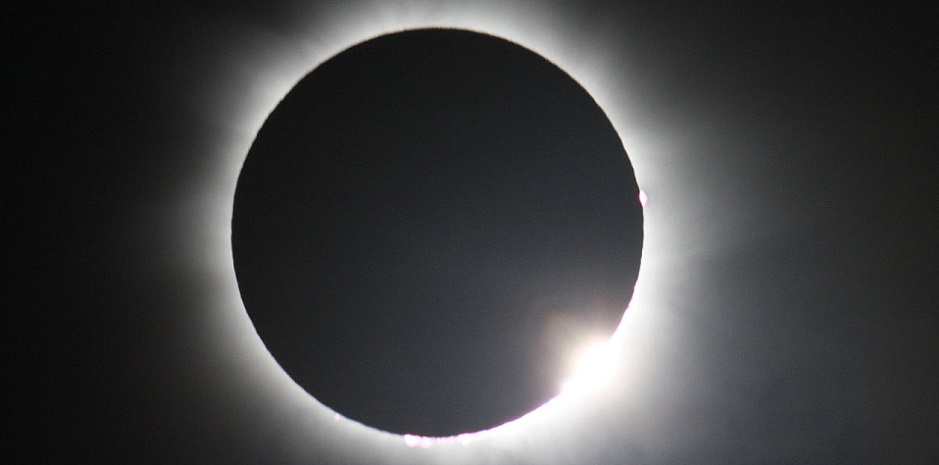
Suddenly, everyone in Kampala is talking about this weekend’s action: not the usual parties and nightclub events, but a hybrid solar eclipse, an event so rare that it only happens every few decades… and guess what? Northern Uganda will be one of the best places in the world to see it!
I can never throw a shoe box away – & finally it’s time to make use of one. Hybrid eclipse 2013, here I come!
The Muzungu first heard about the hybrid eclipse 2013 from an amateur astronomer tip, tap, typing on his keyboard 3410 miles (5488 km) away from Kampala – in Poltava in the Ukraine to be exact. Roman Kostenko – or Роман Костенко in the local Cyrillic script – first wrote to me on 19th February. He explained the uniqueness of the event that will take place this Sunday, November 3, 2013.
Photo courtesy of the Society of Astronomy Amateurs in Poltava, Ukraine http://astrosafari.comIn Roman’s words: “The solar hybrid eclipse occurs on November 3rd, along a narrow strip over the Atlantic Ocean and Equatorial Africa, from Gabon to Ethiopia. In Gulu, Northern Uganda, it will be late afternoon, 17:23, one hour before sunset.
The overall duration of the hybrid solar eclipse will be almost 2 hours, however the total phase is very short: 60 seconds in Gabon, 20 seconds in Uganda and 12 seconds in Kenya. Despite the short duration, this rare kind of hybrid total eclipse will offer us a brilliant glimpse of the solar corona and Bailey beads (outer parts of the Sun emerging between the lunar mountains).
Roman explained that although many people will go to Libreville or Gabon to see the hybrid solar eclipse 2013, “other eclipse chasers have been checking the weather, and will choose Uganda or Kenya, since there are much higher chances of clear skies in the areas north of Lake Albert in Uganda and west of Lake Turkana in Kenya.”
Basic viewing of the totality of the eclipse requires no more equipment than your own eyes, however special filtered ‘eclipse glasses’ are recommended to view the partial phases.
Roman advises: “It is EXTREMELY unsafe to view the eclipsed Sun with binoculars or telescope, unless they have an appropriate solar filter. I would never recommend to use any optical device to look at the Sun before you are confident that it features a properly installed solar filter.
P.S. As the day will turn into deep twilight in less than half an hour, and then back to daytime, and then back to night time (sunset), it will be very entertaining to observe how African wildlife responds to it.”
“Let’s see what the animals make of it….” says the Muzungu…
Roman is a member of the Society of Astronomy Amateurs in Poltava, Ukraine and their brilliant blog has been following their journey to East Africa. (Tip: click on Google translate for the English version of the site!)
“Eclipse chasing is an absolutely international hobby” he told me.
My online research – applied cautiously, Dear Reader – tells me that one of the simplest ways of safely viewing a solar eclipse is by making a shoebox pinhole camera. This enables you to see an image of the solar eclipse, rather than look at it directly. To make one, you will need: a cardboard shoebox, duct tape, knife or razor blade, a white sheet of paper, tinfoil, clear tape, needle or pin, solar eclipse.

Just look at the diagram for how to make a solar eclipse pinhole camera and follow these steps below…
Just copy the diagram for how to make a pinhole camera or follow these steps – or if you can’t be bothered, scroll down for the Muzungu’s Top 10 hybrid solar eclipse 2013 viewing do’s and don’ts.
1. Open your shoebox and cover any cracks or joins with duct tape, to make sure no light can enter your shoebox.
2. Cut a small hole (approx. 1 inch / 1.5cm across) in one end of the shoe box, near one edge.
3. Tape a piece of tinfoil over the hole.
4. Using a pin, make a hole in the centre of the tinfoil.
5. At the opposite end from the foil-covered hole, tape a small piece of white paper to the inside of the box,. The paper should be positioned so that light entering the box through the pin hole will hit it. This is where you’ll look for the sun.
6. Cut a 1 inch / 1.5 cm diameter hole in the box near the image screen (the white piece of paper), but on a different side of the box — the side next to the screen. This is your viewing hole; it must be positioned so that you can look through it at an angle and see the image screen.
7. You now have a pinhole camera. Go find that solar eclipse!
8. Sunday November 3rd 2013: hold the shoe box so that it lines up with its own shadow (meaning it’s aligned with light from the sun). Stand so that when you look through the viewing hole, you can see a tiny bead of light on the image screen: that’s the sun. During hybrid solar eclipse 2013, you’ll see the moon’s shadow pass in front of the sun.
[Information courtesy of @nattyover and www.livescience.com]
In the spirit of participation – admittedly, I was crap at physics at school – I decided I’d try and knock up a pinhole camera for you, but can I find duct tape late at night in Kampala? No. I shall track it down but not this evening… Anyway, you don’t want to get all the way to Northern Uganda and find the tape has come off your wonky old shoebox, do you?
So here are the Muzungu’s Top 10 hybrid solar eclipse 2013 viewing do’s and don’ts:
1. DO NOT use a mirror to view it – that will only do double damage to your eyes
2. The Ugandan Minister of Health’s briefing: “watch it through a black cavera (plastic rubbish bag!)”
3. Standard or Polaroid sunglasses are not solar filters and should not be used to stare at the Sun during the partial phases of an eclipse. You will damage your eyes permanently.
4. DO NOT use film negative.
5. You can make your own filter out of fully exposed and developed black-and-white film, but only true black-and-white film (such as Kodak Tri-X or Pan-X). Such films have a layer of silver within them – this protects your eyes.
6. If you want to observe the eclipse with binoculars or a telescope, you must use a specially designed solar filter on the front end (or Sun-side) of the instrument. (You think they sell them in Pakwach?)
7. Read this bit carefully: if you plan to use binoculars to view the hybrid solar eclipse, totality can and should be observed without a filter, whether with the eyes alone or with binoculars or telescopes. But the partial phases of the eclipse, right up through the Diamond Ring Effect, must be observed with filters over the objective lenses of the binoculars. Only when the Diamond Ring has faded is it safe to remove the filter. And it is crucial to return to filtered viewing as totality is ending and the western edge of the Moon’s silhouette begins to brighten.” If observing the Sun outside of eclipse totality without a filter is quickly damaging to the unaided eyes, it is far quicker and even more damaging to look at even a sliver of the uneclipsed Sun with binoculars that lack a filter.”
8. You can damage your video camera trying to watch the eclipse. Sunlight focused through a lens sets things on fire – do you want to set your camera on fire?
9. Welding goggles or welding glass are safe.
10. And the Muzungu’s personal favourite idea: watch the Uganda solar eclipse reflected in a river – doesn’t that sound romantic?
*DISCLAIMER* my few minutes Googling are not sufficient for me to be sure I’m sharing good advice. Misinformation abounds, and I’m worried I’m making it worse!
It’s always good to have a backup plan! It’s not like many/any? of us are ever going to have a chance to see a hybrid solar eclipse again … but it doesn’t mean you have to permanently damage your eyesight, so don’t get carried away with the moment and do something you will live to regret.
I’m so excited to be in Uganda for hybrid eclipse 2013 and I’m so excited for Uganda to be centre stage for the world, even just for a few moments. Northern Ugandans in particular truly deserve some good publicity.


























I think you did a very thorough job there mother hen! Let’s hope people take notice. No doubt there will be someone selling something that can be used? Hope you have a great experience
Hi Charlotte I rememember the eclipse in the UK around 13 years ago and the birds went silent and all was very eerie. Also the same day as when I had a top wisdom tooth out! Enjoy the experience 🙂
Hi Julie, so do I! I was in Glasgow – a grey miserable day just went a bit greyer! lol. This eclipse looks set to be PRETTY SPECTACULAR by comparison – we hope! Look out for me on the news on Sunday!
Hi Cha. Quite good info you have out there. You really did a good search. But can you tell us what a person in Kampala will see and at what time. I am already in MF on bird counts and hope to wait for the Eclipse!
Hi Di, thanks that’s quite a compliment from you, Dr 🙂
OK so I have done some research and found this very cool website, which has an ‘Eclipse Calculator.’ It gives a lot more information about where you can see the Eclipse e.g. from Kampala! The web site says:
The total phase of this solar eclipse is not visible in Kampala, but it can be observed there as a partial solar eclipse.
The Moon covers a large portion of the Sun, so this is still a spectacular sight.
The animation shows approximately what the eclipse looks like in Kampala (weather permitting).
Hmmm – It’s those last two words that made me decide to travel up North. Also, won’t pollution interfere with the view? And what about all those high-flying Marabou Storks, won’t they get in the way too?!
Excellent blog poѕt. I definitely appreciate tthis websitе.
Keep writing!